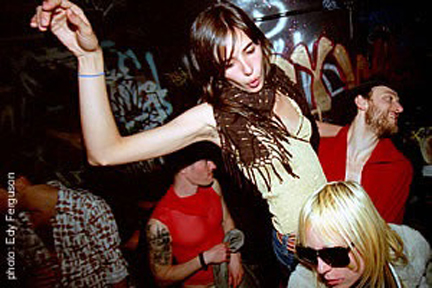Blowing Smoke
“Still Smoking”
Concept and direction by Maria Hassabi
Dance Theater Workshop
New York, NY
April 15, 2006
by Susan Reiter
copyright ©2006, Susan Reiter
 There was plenty of attitude but little substance on view during Maria Hassabi’s hour-long “Still Smoking,” performed by six sleekly intense, vacant-eyed dancers, including the choreographer. According to interviews, Hassabi considers the work the final part of a trilogy—of which I did not see the first two works, presented in New York in December 2004 and in 2003. There was plenty of excitement generated around “Dead is Dead,” 2004 work, but from this latest piece, it’s difficult to glean what got people so worked up.
There was plenty of attitude but little substance on view during Maria Hassabi’s hour-long “Still Smoking,” performed by six sleekly intense, vacant-eyed dancers, including the choreographer. According to interviews, Hassabi considers the work the final part of a trilogy—of which I did not see the first two works, presented in New York in December 2004 and in 2003. There was plenty of excitement generated around “Dead is Dead,” 2004 work, but from this latest piece, it’s difficult to glean what got people so worked up.
Hassabi kept the house closed past the performance’s official starting time, then had the audience file in as the work—or at least a prelude—was already underway. We encountered some members of the cast, slouching in isolation nearby, as we filed in, and Jessie Gold was breathily vocalizing at a microphone onstage. Nineteen beautiful chandeliers of various styles hung high above the stage. The back wall was exposed, as were multiple lighting stand son both sides.
Once the work began more officially, the dancers—four women, two men—were striding along separate paths, barely acknowledging each other. It exuded the languid chic of a fashion show; since not much was going on, we could admire the intriguingly cut, layered and textured black outfits: extra-long fringes dripping form one woman’s vest; a shiny, amazingly cut backless top on another. Gradually, various dancers here and there lifted a leg in a battement or stopped dead and posed. Bleached-blond, elongated Caitlin Cook displayed a snarky sex-kitten aura, while feisty Hristoula Harakas seethed with pent-up energy. One of the men, his hair falling into his face over rose-colored glasses, stared ahead blankly, as though gazing into a void.
Random, basic movement gave way to more coordinated group aerobics, all executed with the same oh-so-bored gaze. The music – al of which was well-chosen and richly textured shifted from a pulsating, looping melody to a wash of electronic noise blended with clanging electric guitar riffs. Occasionally, a dancer came up the center aisle, waited and watched the others, then rejoined the action. Random posing and spurts of unison activity continued, with occasional noticeable moments such as Hassabi shedding first her top, then her shorts, and lying on top of the prone Cook. None of this was given any dramatic emphasis, and the brief contact between dancers—an embrace here, a kiss there —never hinted at any actual engagement between two people. Perhaps Hassabi’s intention was to comment on the empty anomie of an ultra-chic scene in which a fabulous look is all-important.
With plenty of time to wander during the repetitive and increasingly predictable proceedings, my mind considered the implications of the work’s title. Did it refer to being on a hot streak -- as in “he came out smoking” – and was it meant to proclaim an intention of still being hot and au courant? It could also be taken as a defiant, “take that” pronouncement to the politically correct anti-smoking hordes, as if to say, “I’m still smoking and you can just deal with it.”
Hassabi thankfully included no statement of intention or conceptual premise in the program, and the press release was similarly circumspect. But in an interview with Time Out New York’s Gia Kourlas, she made an unfortunately presumptuous analogy between her work and the beginnings of opera, “the moment when everything came together: theater, music, dance and art. That’s what I do.” She should be so lucky as to have her work display that kind of accumulated power, with disparate elements synthesized into a greater whole. One can only wonder what the person credited for "dramaturgy" contributed to the proceedings. The chandeliers—glowing golden for a while, gleaming icy-white, dimming completely—were wonderful, and her dancers certainly know how to pose and look great in black. But the empty and simplistic aerobic routines, random clinches and generalized anomie did little more than fill up time, making an hour feel more like two.
Volume 4, No. 15
April 17, 2006
copyright ©2006 Susan Reiter
www.danceviewtimes.com